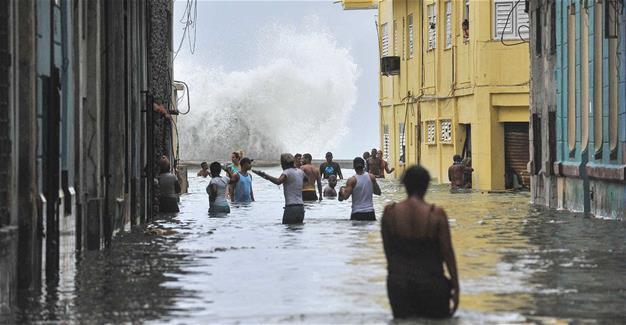Hurricane Irma pounds Florida, extent of damage not yet clear
TAMPA, /MIAMI – Reuters
 Hurricane Irma pounded heavily populated areas of central Florida on Sept. 11 as it carved through the state with high winds, storm surges and torrential rains that left millions without power, ripped roofs off homes and flooded city streets.
Hurricane Irma pounded heavily populated areas of central Florida on Sept. 11 as it carved through the state with high winds, storm surges and torrential rains that left millions without power, ripped roofs off homes and flooded city streets.Irma, once ranked as one of the most powerful hurricanes recorded in the Atlantic, came ashore in Florida on Sunday and battered towns as it worked its way up the state.
The storm gradually lost strength, weakening to a Category 1 hurricane overnight, the National Hurricane Center said. By 5 a.m. locla time, Irma was churning northwest in the center of the state and was about 100 kilometers north of Tampa, with maximum sustained winds of 12 kilometers per hour.
Much of the state’s east and west coasts remained vulnerable to storm surges, when hurricanes push ocean water dangerously over normal levels. That risk extended to the coast of Georgia and parts of South Carolina, the hurricane center said.
Officials planned to wait until first light on Sept. 11 to begin rescue efforts and assess damage, the Miami Herald cited Florida Director of Emergency Management Bryan Koon as saying. He did not give any numbers on possible fatalities.
Damage appeared to be severe in the Florida Keys, where Irma first came ashore as a Category 4 hurricane with sustained winds of up to 215 kph in the early hours of Sept. 10, the paper quoted Monroe County Emergency Director Martin Senterfitt as saying.
A large military airborne relief operation was being prepared to take help to the chain of islands, which are linked by a dramatic series of bridges and causeways from Key Largo almost 160 kilometers southwest to the city of Key West, Senterfitt told a teleconference.
Early on Sept 11, Irma brought gusts of up to 160 kph and torrential rain to areas around Orlando, one of the most popular areas for tourism in Florida because of its cluster of theme parks, the National Weather Service said.
In Daytona Beach, a city on the east coast about 90 kilometers northeast of Orlando, city streets were flooded and emergency authorities carried out several water rescues, the Daytona Beach Police Department said on Twitter.
Over the weekend, Irma claimed its first U.S. fatality - a man found dead in a pickup truck that had crashed into a tree in high winds in the town of Marathon, in the Florida Keys, local officials said.
The storm killed at least 28 people as it raged westward through the Caribbean en route to Florida. Irma was ranked a Category 5, the rare top end of the scale of hurricane intensity, for days, and carried maximum sustained winds of up to 295 kph when it crashed into the island of Barbuda on Sept 6.
Ahead of Irma’s arrival, some 6.5 million people in southern Florida, about a third of the state’s population, were ordered to evacuate their homes.
Jonathan Brubaker, 51, waited out the storm bunkered in a recently constructed house in Bradenton, on the state’s west coast, with hurricane shutters drawn, flashlights and candles ready. As a radar app on his phone showed Irma passing by, he had seen little more than gusty winds. He still had power.
“I feel like we kind of dodged bullet on this one,” he said
High winds snapped power lines and left about 5.8 million Florida homes and businesses without power, state data showed. Many of the evacuation orders extended until at least Monday due in part to flooding, massive power outages and downed electric lines, leaving residents unable to return to their homes to survey any damage.
TV news video of damage in Naples, a city on the Gulf coast about 200 kilometers of Miami, showed buildings ripped apart by winds and streets flooded by rain and storm surges.
Miami International Airport, one of the busiest in the country, halted passenger flights through at least on Sept. 11.
Irma was forecast to weaken to a tropical storm as it moved near Florida’s northwestern coast on Monday morning, the National Hurricane Center said. It would cross the eastern Florida Panhandle and move into southern Georgia later in the day, dumping as much as 41 centimeters of rain, it said.
Five tornados were reported in Florida on Sept. 10, causing damage to several structures but there were no indications of anyone being seriously injured, the National Weather Service said.
















